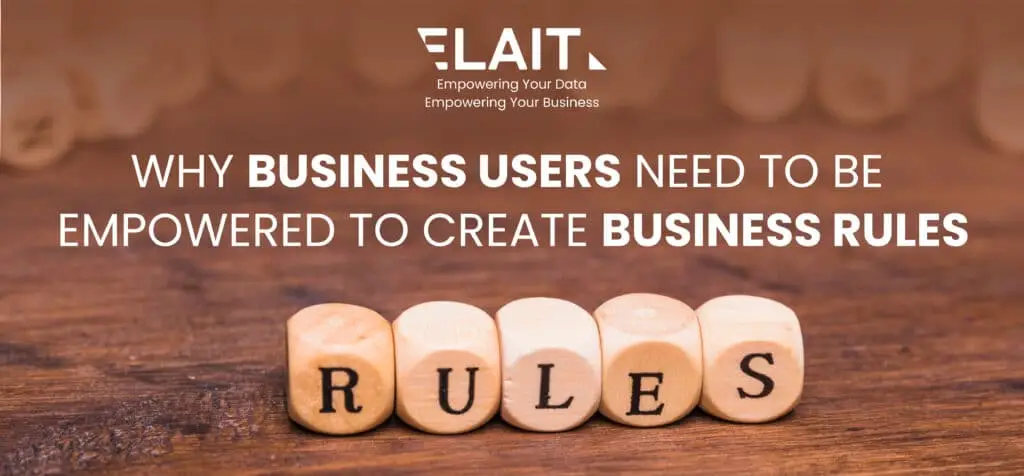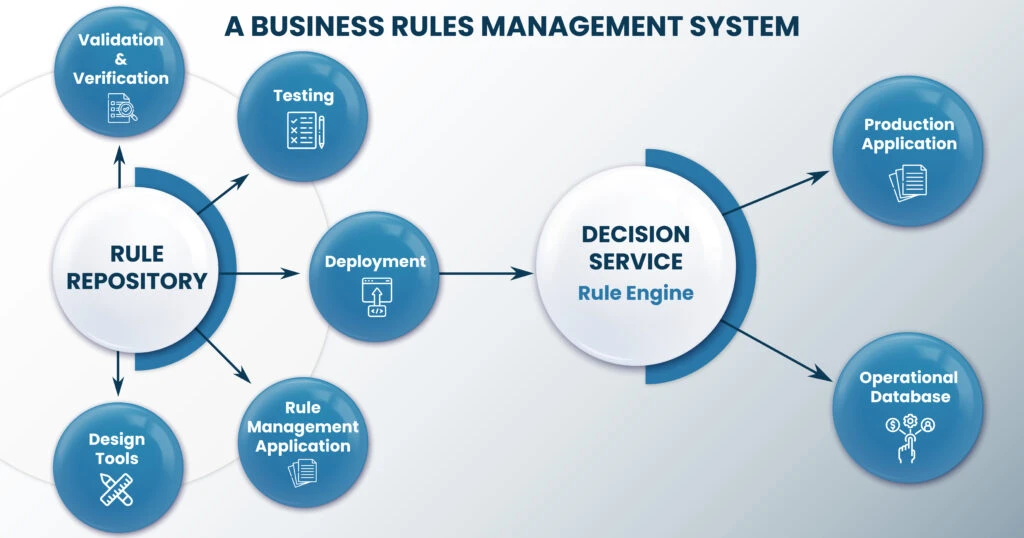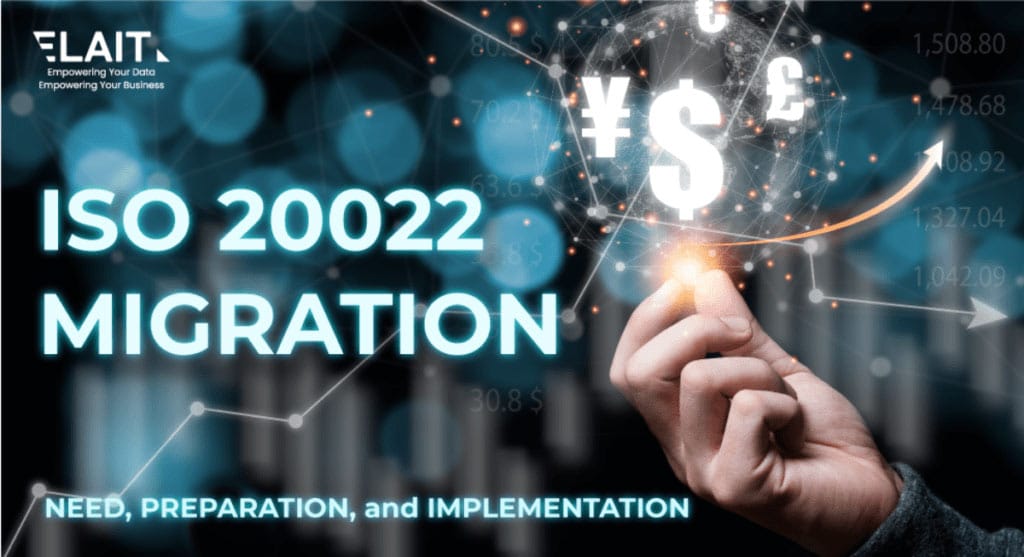What are Business Rules ?
Business rules are specific instructions or constraints on day-to-day actions that guide decision-making within businesses. They set expectations, provide guidance, ensure compliance and help organize and automate business processes within corporations.
Business rules can be applied in a variety of ways and control responses to business queries in many aspects of an organization.
The translation of business activities into concrete business rules allows businesses to apply these rules within various applications and tools to enable automation. Therefore, intelligent identification & understanding of dynamics of the marketplace, implementation and adoption of business rules and logic play an essential role in enhancing the efficiency of an organization.
Business rules are composed of facts and conditional statements. Traditionally embedding a business rule in a process is a lengthy procedure with multiple steps involving business analysts, development, and testing teams. Going through this long & often iterative process of creating, embedding & validating the logic of managing business rules can become quite complex.
Businesses can take anywhere between 8 to 12 weeks to implement a business rule.
The amount of time spent to generate production worthy code that empowers business users varies according to the complexity of the business, process, and application.
Hence, it becomes crucial to bring this cycle of discovery, transition to code & the validation of business rules faster to ensure business agility, efficiency, and effectiveness.
Business Rules v/s Business Processes

Business rules can be classified in many ways. These rules are the foundation of a business rules engine that allows organizations to automate business decisions for various processes such as customer orders, shipping, etc. Irrespective of their classification, they are expressed using formal logic qualifiers such as “ONLY IF”, “WHEN”, “IF-THEN”, etc. The two main types of business rules are:
- Constraint Rules
A constraint business rule is used to manage constraints on tables and columns, much like an MS Excel Spreadsheet. These rules set conditions that place restrictions on object structures. They are further sub-categorized into stimulus and response, operation constraints, and structure constraints.
- Stimulus and response require conditions to be true before action is taken.
- Operation constraint rules place restrictions before and after an action.
- Structural constraints rules establish policies around objects, classes, and the relationship between them.
- Derivation rules
A derivation business rule defines conditions that evaluate facts, by calculations or classification, leading to new facts. They further subset into inference rules and computational rules.
- Inference rules confirm if a business scenario is true or not.
- Computational rules utilize algorithms to make such inferences.
Examples of Business Rules
- Discount Rules
Business rules are commonly used to offer customer discounts in the retail sector. For example, an organization might decide on a discount on purchases once a threshold is reached. If a customer spends $5,000, in a calendar year, then a discount of 10% will be rewarded on each item.
- Suspicious Transactions Alerts
Financial companies rely on automation to flag suspicious transactions. For example, credit card transitions over $1,000 would require a representative to contact the cardholder to verify the transaction.
- Automate Loan Approval
When applying for a home loan, banks must collect a lot of information such as house details, cardholder’s credit score, credit history, etc. Business rules can automate the process by specifying a minimum credit score to qualify for a specific interest rate.
- Sales Commissions
Many employees are compensated on a commission basis or awarded bonuses based on performance. Automation simplifies this process. A business rule can be, if an employee sells goods worth $50,000 within a year, they will be awarded a bonus of $500.
- Perform Calculations
When an employee prepares an invoice, manually calculating subtotals and totals are prone to errors. As a result, you may end up underpaying or overpaying invoices. “Calculation Business Rules” can automate the process and mitigate errors.
Importantly, for each of the types of rules listed above, the marketplace’s dynamism constantly demands flexibility to maximize customer experience.
For instance, in the context of the first example mentioned as part of “Discount Rules”, while the stated condition may be over-arching, there could be exceptions depending on customer history, item(s) purchased etc, that could demand more or less discount values.
The agility with which a business user responds to enhance this customer demand/situation is key to customer retention and market expansion. That’s the paramount measure that will differentiate various BRMS platforms from the next generation ones that provide capabilities to manage business rule automation.
What Business User-Driven Configurability of Business Rules Help Achieve
Bringing down the control of Business Rules configurability at the level of the business users yield several benefits, which streamline business operations and subsequently reduce cost.
- Increased Efficiency
Programming business rules into the workflow saves time in the long term. For example, when rules are updated due to regulatory modifications, if only that aspect can be changed without re-coding, the implementation will help in greater control over business processes.
- Increased Consistency
Business rules ensure tasks are consistently executed within the framework of multiple criteria that need to be met for an action to be executed. Regulatory agencies require the adherence to specific documentation as prescribed by the norm. A point to consider when multiple options seem contradictory yet inter-related is to create custom templates that will enforce compliance when all relevant fields are marked as complete. This leads to fewer chances of error, and business leaders can be assured that they meet compliance requirements.
- Enhanced Productivity & Customer Retention
Imagine the customer’s delight when not having to wait for an answer on an option he considers crucial. Providing the customer-facing managers with the power to quickly exhibit evidence to bolster their decisions help “reach-out programs” excel.
Automating Business Rules
A Business Rules Management System (BRMS) plays a vital role in automating business rules. BRMS are software solutions that define, execute, monitor, and manage business rules. The following three components are part of any business rules management system,
- The development environment for creating business rules.
- The repository where they can be stored for review, edit, and propagation within an enterprise.
- The business rules engine that supports real-time execution.
It’s critical that BRMS stores rules in a repository that collects, stores, and manages data rather than embedding rules within code and provides user-friendly tools that allow users to manage business rules without the need to write code.
The key enabler one should look for is whether the interfaces are friendly enough to be directly used by the business users. In the context of data management programs, it is also essential to spot a solution that closely integrates with the Data Management platform, one’s corporation leverages or choose a Data Management platform with a built-in module or functionality that supports standard BRMS capabilities.
For example, Business Rule Engine and Express>it from Ab Initio, allows analysts to write business rules with minimal technical knowledge. Ab Initio can perform a wide range of preload transformations through the graphical interface in its Business Rules Environment. Thus, Ab Initio makes developing, storing, editing, and executing business rules much simpler today. They can help business users turn data into actionable intelligence significantly faster, reducing the wait time.
Advantages Empowering Business Users with the Ability to Configure Business Rules
Business rules to automate decision-making have been part of the workflow for many years. Decision management tools allow organizations to work more effectively and manage complex business rules.
However, sound programming skills are often required to create and manage them. Even though analysts and developers are equipped with such technical skills they become the bottleneck when a business user requests for a minor though the essential change in existing workflow or the logic. This significantly slows down the pace of automation, which in turn costs time and money to an organization. They may even lose the customer.
Ab Initio allows business users to create and manage business rules themselves, considerably reducing the time taken to implement rules.
- It empowers business users to leverage configurable & reusable templates of business rules with several levels of granularity.
- The platform also helps create configurable user profiles with a broad range of permissions. It enables business experts to use tools as per their objectives and level of experience.
- It offers various versions of business rules to enhance the current processing environment or help build a new one.
This sort of graphic environment empowers business experts to create business rules themselves, rather than relying on Information Technology professionals. The fact that business users can create, alter and manage business rules without involving IT professionals saves time and speed up the processing time thus empowering business.
Case Study
A mid-sized insurance company realized the need to move from a plethora of policies implemented across applications to an integrated system that would enable products to move in a more unified manner. The company started using process analysis techniques to understand its current state, identify process gaps, and opportunities. Like most companies, they found business rules hidden in the policy documentation, with subject matter experts, and within system code.
The work to collect and integrate business rules was painstaking; however, the company soon began to see the long-term benefits of collating and documenting its business rules, even revamping them in the context of contemporary customer queries.
Business experts facilitated to elicit information and to document it properly. As a result, they now have a well-defined set of business rules, the impacts of which are traceable across products, processes, data, events, and roles. Importantly, the corporation chose a platform that offered business rule configurability at the level of the business user.
At Elait, we help businesses cut development costs by building business solutions leveraging the experience of the best Ab Initio talent in the industry to drive business without traditionally large development teams.
Leveraging Ab Initio’s Express>It, we empower Business teams to make changes without the ongoing cost of successive project teams.



